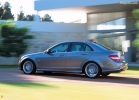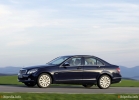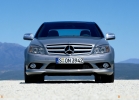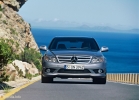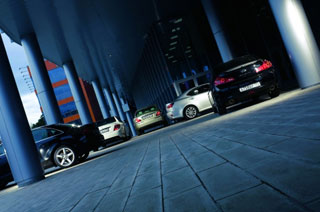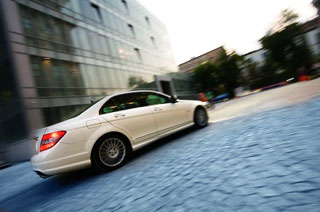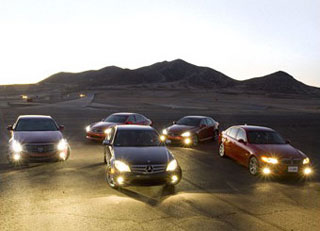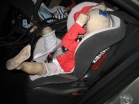Test drive Mercedes Benz C-class W204 since 2007 sedan
Reverse curtsy or other reading?
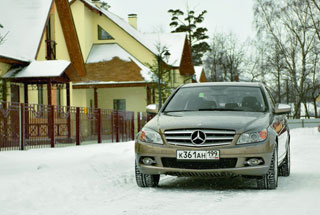 Reliability, quality, solidity, confidence in their abilities, prestige I think, no one will argue that all these epithets are certainly applicable to cars with a three -beam star. Having taken the Mercedes C280 for the updated 4Matic drive system, we realized that it builds these advantages to an even higher level.
Reliability, quality, solidity, confidence in their abilities, prestige I think, no one will argue that all these epithets are certainly applicable to cars with a three -beam star. Having taken the Mercedes C280 for the updated 4Matic drive system, we realized that it builds these advantages to an even higher level. To be the owner of Mercedes is a special status. This, if you want, is a pass to the elite automobile club. This is a universal and widespread respect. The phrase accidentally dropped in a conversation, I go on a Mercedes, makes an impression on the interlocutors, close to what a man in yellow pants of Ku twice, and nothing else on the heroes of the film Kin-dza-dza. Apparently, this authority presses not only others, but also on the owners themselves. Moreover, to such an extent that, according to our editor -in -chief, by and large, according to the drum, certain nuances in the management of the machine and its habits in their natural snobbery, they simply do not descend before that.
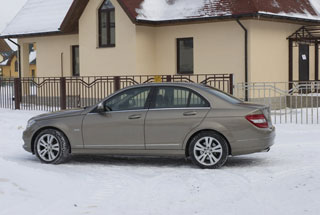 It is difficult for most happy owners of the Mercedes car that is difficult to disagree with this and really enough contemplation of the rest of the world through the sight on the hood, lulling comfort, smoothness and peaceful silence in the cabin, they find their happiness not in understanding the difference between insufficient and excessive rotation. However, in any rule, as you know, there are exceptions, and in any, even the most prosperous family, does not do without originals. Recall that Mercedes also had models with a truly sports character.
It is difficult for most happy owners of the Mercedes car that is difficult to disagree with this and really enough contemplation of the rest of the world through the sight on the hood, lulling comfort, smoothness and peaceful silence in the cabin, they find their happiness not in understanding the difference between insufficient and excessive rotation. However, in any rule, as you know, there are exceptions, and in any, even the most prosperous family, does not do without originals. Recall that Mercedes also had models with a truly sports character. Without climbing far into the wilds of history like 300 SL, and even, moreover, limited to classic sedans, we note at least the E500 in the body of W124 a wonderful, fast and sharp car management. And this is not to mention the versions of AMG, which are on equal terms with BMW M and Audi RS.
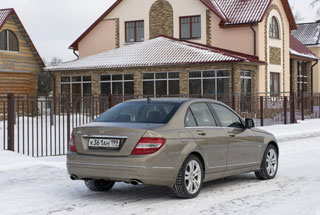 That is, of course, among the admirers of cars from Stuttgart, there are active drivers of those who understand in most cases people of a rather young, by the standards of Mercedes, age. And having presented a new generation from class last year, Stuttgarts, in my opinion, made a curtsy in their direction. At the same time, killing two birds with one at once, creating a car much more interesting outwardly and in management and providing the opportunity to get into the Mercedes club for a completely moderate fee of those who were not prone to such a purchase before only because of the lack of sufficient control interactivity.
That is, of course, among the admirers of cars from Stuttgart, there are active drivers of those who understand in most cases people of a rather young, by the standards of Mercedes, age. And having presented a new generation from class last year, Stuttgarts, in my opinion, made a curtsy in their direction. At the same time, killing two birds with one at once, creating a car much more interesting outwardly and in management and providing the opportunity to get into the Mercedes club for a completely moderate fee of those who were not prone to such a purchase before only because of the lack of sufficient control interactivity. Since this spring, it has become possible to purchase all -wheel drive versions from the C280 and C350 class. They are equipped with a 4Matic of the last generation of all -wheel drive, which previously made a year's debut on the top model S class. The handout here is made in the same case with a hydromechanical gearbox 7G Tronic, with a single lubricant system, unlike the previous full -wheel drive system, which was installed on the ced until 2006. Design in
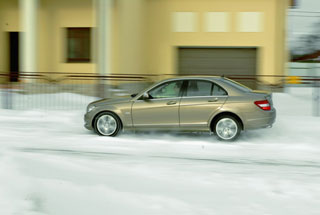 the whole turned out to be easier and more compact with a class with four leading wheels by only 65 kg heavier than its rear -wheel drive fellow. Mechanical losses and noise became less. Mercedes technical specialists assure that 4Matic should easily withstand a mileage of 300,000 km. The cylindrical center differential divides the torque in the proportion of 55:45 in favor of the rear wheels, and the 4TS (Electronic Traction System) system, inhibiting one or two wheels, takes the role of free inter -fire differentials.
the whole turned out to be easier and more compact with a class with four leading wheels by only 65 kg heavier than its rear -wheel drive fellow. Mechanical losses and noise became less. Mercedes technical specialists assure that 4Matic should easily withstand a mileage of 300,000 km. The cylindrical center differential divides the torque in the proportion of 55:45 in favor of the rear wheels, and the 4TS (Electronic Traction System) system, inhibiting one or two wheels, takes the role of free inter -fire differentials. How does all this manifest itself in practice?
If the rear -wheel drive with the class seemed somewhat frivolous and playful, although in fact he only acquired transparency and acuteness in management, then 4Matic is much more traditional as Mercedes in the generally accepted understanding of the word. When moving on slippery and heterogeneous coatings, equanimity and stability affects it. Where the rear -wheel drive with the class, without stopping, blinks the yellow triangle ESP on the front panel, 4Matic is amazingly unshakable. He did not care either the snow-reagent porridge of Moscow avenues, nor a mixture of asphalt and ice highway. He inspires exactly the sense of confidence that Stuttgart cars are so famous for.
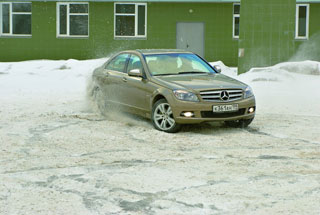 Naturally, C280 4MATIC is much more confident in the start. Regardless of the fact that under the wheels, this confidence develops into an assertive straightforward acceleration that does not require any steering. But more confident, alas, does not mean faster. Although, according to the passport, acceleration up to hundreds takes only a couple more time than the usual rear -wheel drive modification, in fact it seems much calmer. It is not only the increased mass of the car to blame for this. A miniature handout is not able to digest torque of more than 700 nm. Therefore, the maximum torque, already missed through the first gear, was decided to limit at this level. In addition, according to my subjective sensations, there were not without reprogramming the electronic brain 7G Tronic. In any case, the transfers switch more smoothly, and neither sports nor even manual regimes have the necessary sharpness and speed. The checkpoint works calmly, without fuss. One word Mercedes
Naturally, C280 4MATIC is much more confident in the start. Regardless of the fact that under the wheels, this confidence develops into an assertive straightforward acceleration that does not require any steering. But more confident, alas, does not mean faster. Although, according to the passport, acceleration up to hundreds takes only a couple more time than the usual rear -wheel drive modification, in fact it seems much calmer. It is not only the increased mass of the car to blame for this. A miniature handout is not able to digest torque of more than 700 nm. Therefore, the maximum torque, already missed through the first gear, was decided to limit at this level. In addition, according to my subjective sensations, there were not without reprogramming the electronic brain 7G Tronic. In any case, the transfers switch more smoothly, and neither sports nor even manual regimes have the necessary sharpness and speed. The checkpoint works calmly, without fuss. One word Mercedes 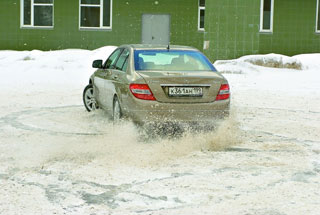 In the front suspension of all -wheel drive ceses, other levers and rotary fists are used. I also had to install more rigid springs and shock absorbers to compensate for the weight of the front -wheel drive. To place the anterior bridge gearbox, the steering rack was transferred 7 cm forward. It would seem not so significant changes. But they had a rather tangible effect on behavior with the class. And first of all, this applies to cleanliness and transparent steering. Unfortunately, with the advent of the 4Matic system, so that last year liked the test drive of rear -wheel drive models at the Dmitrovsky landfill, which was so much like and responsiveness of the steering wheel, has disappeared. At low (approximately 40 km/h) speeds, there is absolutely no reactive effect. It comes to the point that with slow maneuvers you have to return the steering wheel to its original position.
In the front suspension of all -wheel drive ceses, other levers and rotary fists are used. I also had to install more rigid springs and shock absorbers to compensate for the weight of the front -wheel drive. To place the anterior bridge gearbox, the steering rack was transferred 7 cm forward. It would seem not so significant changes. But they had a rather tangible effect on behavior with the class. And first of all, this applies to cleanliness and transparent steering. Unfortunately, with the advent of the 4Matic system, so that last year liked the test drive of rear -wheel drive models at the Dmitrovsky landfill, which was so much like and responsiveness of the steering wheel, has disappeared. At low (approximately 40 km/h) speeds, there is absolutely no reactive effect. It comes to the point that with slow maneuvers you have to return the steering wheel to its original position. 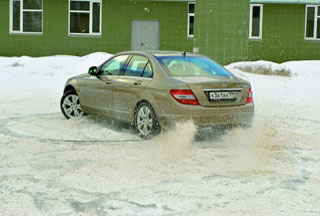 With increasing speed, feedback appears, but it seems somewhat synthetic, fake. This, again, sets up on a calm, pacifying ride and roll to your cottage, not thinking that there is asphalt, snow or water on the road, abstracting the wheel of a multimedia system. Really, with the release of all -wheel drive modifications from the class, the Mercedovites themselves were frightened of excessive sports and decided to fit a little Tsshka? I do not think that this was a paramount task. Most likely, these are just the inevitable consequences of the 4x4 drive. After all, the Agility Control suspension is still magnificent. Elastic and assembled, with small rolls in corners, she nevertheless stores comfort laid in the cabin to the car Mercedes. You rarely meet such a successful compromise. In addition, 4Matic himself is able to deliver a lot of pleasure to the sophisticated driver.
With increasing speed, feedback appears, but it seems somewhat synthetic, fake. This, again, sets up on a calm, pacifying ride and roll to your cottage, not thinking that there is asphalt, snow or water on the road, abstracting the wheel of a multimedia system. Really, with the release of all -wheel drive modifications from the class, the Mercedovites themselves were frightened of excessive sports and decided to fit a little Tsshka? I do not think that this was a paramount task. Most likely, these are just the inevitable consequences of the 4x4 drive. After all, the Agility Control suspension is still magnificent. Elastic and assembled, with small rolls in corners, she nevertheless stores comfort laid in the cabin to the car Mercedes. You rarely meet such a successful compromise. In addition, 4Matic himself is able to deliver a lot of pleasure to the sophisticated driver. 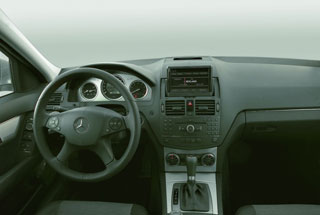 Go to the huge snowy platform! I note that the ESP system is also borrowed from the senior C class. Its main features are the ability to very correctly, almost imperceptibly in the driving of a car for its stabilization in a critical moment (in the on state) and a rather large degree of freedom in partially disconnected. In practice, this means that the 4Matic with the ESP turned off allows for driving. If the situation gets out of control, ESP, of course, will still pull the car. But, if everything is done correctly, slightly turn the steering wheel in the direction of turn and open the gas a little, then you can maintain a car for a skid under the traction for a very long time. It is amazing that, not possessing the rear differential (like Mitsubishi Evo or BMW with a new XDRive) 4Matic is also capable of acceleration from skidding. The main thing is not to make sharp movements by the steering wheel and do not touch the brake pedal, otherwise ESP will wake up and break the entire buzz.
Go to the huge snowy platform! I note that the ESP system is also borrowed from the senior C class. Its main features are the ability to very correctly, almost imperceptibly in the driving of a car for its stabilization in a critical moment (in the on state) and a rather large degree of freedom in partially disconnected. In practice, this means that the 4Matic with the ESP turned off allows for driving. If the situation gets out of control, ESP, of course, will still pull the car. But, if everything is done correctly, slightly turn the steering wheel in the direction of turn and open the gas a little, then you can maintain a car for a skid under the traction for a very long time. It is amazing that, not possessing the rear differential (like Mitsubishi Evo or BMW with a new XDRive) 4Matic is also capable of acceleration from skidding. The main thing is not to make sharp movements by the steering wheel and do not touch the brake pedal, otherwise ESP will wake up and break the entire buzz. 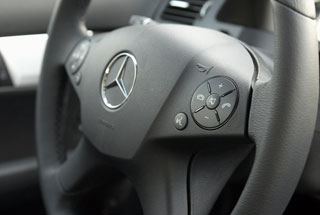 However, a reasonable question arises again: does the owner of Mercedes need all this? Maybe he is enough for the confidence and security that is ensured by all -wheel drive on our nine months a year of disgusting roads? But why then not to buy some comparable crossover at a price? Or maybe he needs everything that was listed at the beginning of the article Reliability, quality, solidity, confidence in his abilities, prestige? No, perhaps, making a choice in favor of class 4matic, he acquires both. Plus, some exclusivity plaque, after all, are not so many all -wheel drive Mercedes. And if the owner is also a little unconventional (in terms of automobile preferences and driver's skills, of course), then, being on a safe platform or snowy deserted winding paths, he will receive a lot of pleasure from managing this very company
However, a reasonable question arises again: does the owner of Mercedes need all this? Maybe he is enough for the confidence and security that is ensured by all -wheel drive on our nine months a year of disgusting roads? But why then not to buy some comparable crossover at a price? Or maybe he needs everything that was listed at the beginning of the article Reliability, quality, solidity, confidence in his abilities, prestige? No, perhaps, making a choice in favor of class 4matic, he acquires both. Plus, some exclusivity plaque, after all, are not so many all -wheel drive Mercedes. And if the owner is also a little unconventional (in terms of automobile preferences and driver's skills, of course), then, being on a safe platform or snowy deserted winding paths, he will receive a lot of pleasure from managing this very company Brief story 4matic
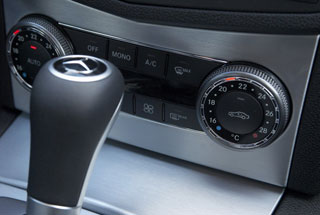 For the first time, 4Matic (4-Wheel Drive and Automatic) has become available to the Mercedes E260, E300 and E300 D in the body of W124 in 1987. The handout consisted of two clutch controlled by hydraulics. In fact, it was the so -called Torque on Demand (moment on demand), well familiar to us now for most SUVs. But the principle of work was still somewhat different. The transmission functioned in one of the four modes, each of which was selected automatically as a result of a survey of ABS sensors and the steering wheel rotation angle sensor.
For the first time, 4Matic (4-Wheel Drive and Automatic) has become available to the Mercedes E260, E300 and E300 D in the body of W124 in 1987. The handout consisted of two clutch controlled by hydraulics. In fact, it was the so -called Torque on Demand (moment on demand), well familiar to us now for most SUVs. But the principle of work was still somewhat different. The transmission functioned in one of the four modes, each of which was selected automatically as a result of a survey of ABS sensors and the steering wheel rotation angle sensor. In the first mode, the 100% torque was betrayed on the rear axle, at the second moment it was distributed in the proportion of 65:35 in favor of the rear axle, in the third equally 50:50, and in the fourth, the ASD rear differential was additionally included in the work. When the ABS is triggered, the four -wheel drive turned off. When acceleration, the front wheels were always connected, regardless of whether the rear or not were axle. The system was produced in two versions (from 1987 to 1991 and from 1992 to 1997) that differed
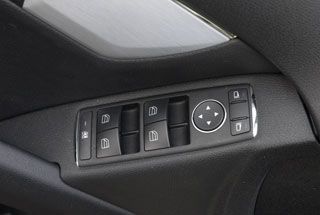 the method of turning off the drive to the front axle. Both of these options were not reliable. At the same time, as a result of locks and unequal redistribution of torque, the transmission experienced serious loads, which, in turn, required the manufacture of more durable, and therefore expensive and heavy details. In 1997, the production of the system was curtailed.
the method of turning off the drive to the front axle. Both of these options were not reliable. At the same time, as a result of locks and unequal redistribution of torque, the transmission experienced serious loads, which, in turn, required the manufacture of more durable, and therefore expensive and heavy details. In 1997, the production of the system was curtailed. The next generation of 4Matic was presented in the E class of W210 in 1998. It was developed in conjunction with Steyr-Daimler-Puch. This was already a real system of constant all -wheel drive, where torque was distributed in a proportion of 60:40 (for cars, except C and C of classes) in favor of the rear wheels or equally 50:50 (for models GL, ML and R). The peculiarity of the 4matic system of this generation is that
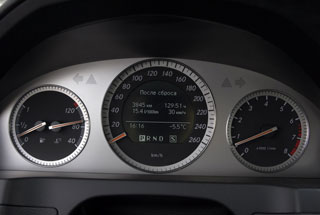 blocks of the center and inter -normal differentials are replaced by a system of control of the traction force of 4ets (Electronic Traction System). It brakes sliding wheels, thereby increasing the torque on wheels that have sufficient grip with the road. The 4ets system, in turn, is integrated into the ESP stabilization system.
blocks of the center and inter -normal differentials are replaced by a system of control of the traction force of 4ets (Electronic Traction System). It brakes sliding wheels, thereby increasing the torque on wheels that have sufficient grip with the road. The 4ets system, in turn, is integrated into the ESP stabilization system. Getting data from the ABS sensors, the angle of rotation of the controlled wheels, the rotation speed of the car relative to the vertical axis and transverse acceleration, the ESP distributes the brake moment or reduces (increases) the torque, which allows the car to stabilize. Having undergone modernization in 2002 (4ets+), this
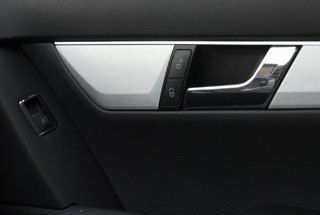 option 4matic is now used on most Mercedes models.
option 4matic is now used on most Mercedes models. The tested Mercedes C280 was equipped with a 4matic of the last generation. The same is installed on the flagship of the model range S class. The principle of its work remained the same, but the Austrians from Steyr-Daimler-Puch did not participate in its development. There are some very significant changes. A free center differential gave way to another, partially blocked by a multi -disc clusion, as a result of which the torque is distributed in a proportion of 55:45 in favor of the rear axle. In turns or on mixed
 (heterogeneous) coatings, when the difference between the twisting moments between the front and rear bridges becomes more than 50 nm, the friction fruit slips, and then the 4ets system comes into business.
(heterogeneous) coatings, when the difference between the twisting moments between the front and rear bridges becomes more than 50 nm, the friction fruit slips, and then the 4ets system comes into business. Unlike the 4matic of the previous generation, the handout is now located in the same block with the checkpoint, and the front wheel drive shaft is pressed as much as possible to the box body, which allowed to leave the central tunnel of the body without alterations. The gears for reducing noise are made more scanty. If earlier Mercedes with all -wheel drive was heavier than usual by 105 kg, now only by 65. Accordingly, the difference in fuel consumption has decreased (from 1.1 to 0.3 l). In the future, the new version of the 4Matic will appear on the GLK crossover and the new generation class.
Dmitry Krotov
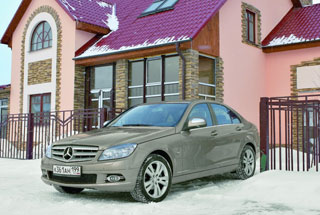
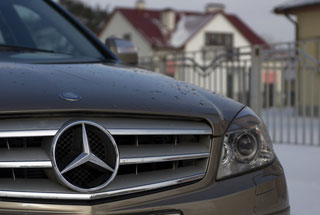
Source: Motor magazine [April 2008]
Video test drives Mercedes Benz C-class W204 since 2007
Video crash tests Mercedes Benz C-class W204 since 2007
Test drives Mercedes Benz C-class W204 since 2007
Crash Test Mercedes Benz C-class W204 since 2007
Krassh Test: Detailed Information36%
Driver and passengers
11%
Pedestrians
32%
Children-passengers

